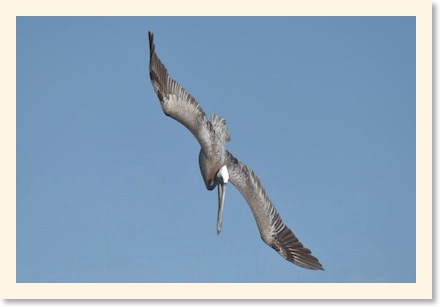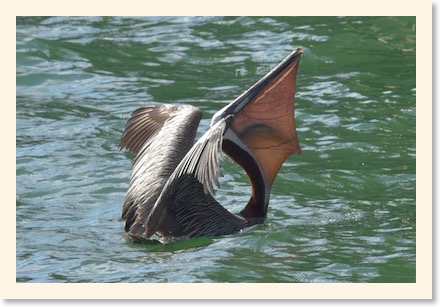The Pelican
Article and photograph by by D.W. Cloud

The pelican cannot straighten its neck, because its eighth vertebra is joined with the seventh and ninth.
Pelicans live in every continent except Antarctica and build their nests in colonies.
The brown pelican fishes by plunge-diving headfirst into the water. The accompanying photo taken from a bridge in Florida captures a brown pelican in a dive. Its sharp eyes can see the fish from 60-70 feet in the air, in spite of the glare of the water, and it has the amazing ability to time its plunge and judge its angle perfectly to capture prey. It hits the water with such force that fish under the surface are momentarily stunned, and when its bill touches the water, the pelican pushes its legs and wings back to create more force (Elise Willitt, "The Biogeography of the California Brown Pelican," San Francisco State University, 2001). There are air sacs under the bird's skin to cushion the impact, to help it swim back to the surface, and to help keep it afloat. The pelican's bill is sensitive and helps the bird locate fish in murky water.

The opening and closing of the pouch is controlled by a complex set of tongue muscles. By contracting and relaxing the muscles, the bird can flutter its pouch at a rate of 200 times a minute as a cooling mechanism.
The pelican has a gland at the base of its tail that produces waterproof oil that it uses to coat its feathers to keep them from becoming waterlogged.
The pelican is a great flier and can float beautifully on thermals that rise from the water.
To fly from a sitting position on the water, the bird must flap its large wings and literally pound the surface of the water with both its feet in unison to gain enough speed to lift off.
A group of flying pelicans is called a "squadron."
The pelican sleeps by turning its head backwards and laying the long beak on its back.
During courtship, the pelican's bill and pouch becomes multi-colored, part bright salmon pink, part yellow, part cobalt blue, with a black diagonal strip appearing from base to tip of the bill. The eggs are incubated on the parents' feet, and the unborn chicks communicate with their mothers as to whether they are too hot or cold. .


